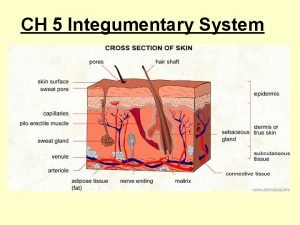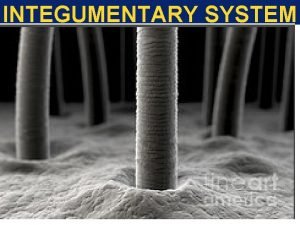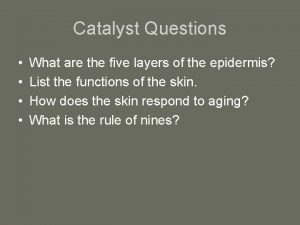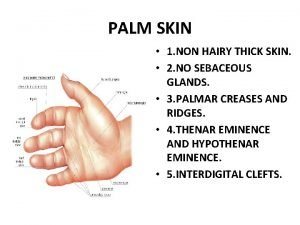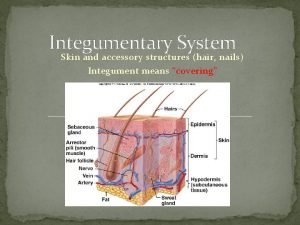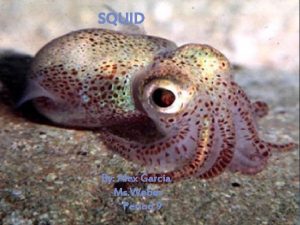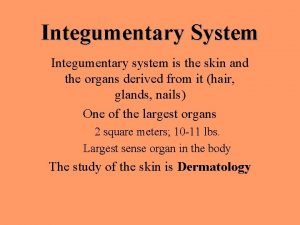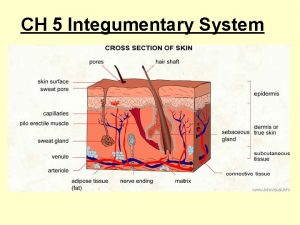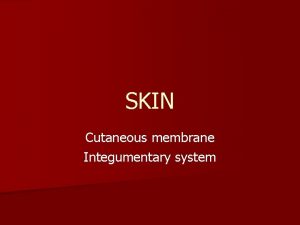Integumentary System Part 1 The Integumentary system skin













































































- Slides: 77

Integumentary System Part 1

The Integumentary system (skin) is made up of several layers: • The hypodermis • The epidermis • The dermis

The Hypodermis This layer is under the dermis and is not considered part of the skin. It serves to separate the skin from the underlying muscle.

The Hypodermis This layer contains fat tissue and is loosely anchored to the skin. This allows the skin to slide while the fat serves as an insulator and a cushion

The Hypodermis

The Hypodermis • This layer is the major site of fat accumulation • Distribution differs among the sexes. Its in the thighs and breasts of females and the belly of males

Epidermis • This is the outer most layer and consists of a stratified squamous epithelium. • Four cell types populate it:

Epidermis • This is the outer most layer and consists of a stratified squamous epithelium. • Four cell types populate it: – Keratinocytes – Melanocytes – Epidermal dendritic cells (Langerhan’s cells) – Tactile cells (Merkel cells)

Keratinocytes • These cells produce keratin, a protein made of intermediate fibers.

Keratinocytes • These cells produce keratin, a protein made of intermediate fibers. • These cells attach to each other by desmosomes.

Keratinocytes

Keratinocytes • These cells are found in the lowest level of the epidermis, the stratum basale (basal cell layer). • These cells divide and give rise to the major epithelial cell type in the epidermis.

Keratinocytes • These cells divide and are pushed towards the upper layers of the epidermis.

Melanocytes • These cells produce melanin and are found occupying the stratum basale.

Melanocytes • These cells produce melanin and are found occupying the stratum basale. • Melanin is stored in intracellular vesicles called melanosomes.

Melanocytes

Melanocytes • The melanocytes are “spider” shaped. • The melanosomes migrate to the distal portions of the melanocyte where it is secreted. • The melanin is then taken up by the keratinocytes.

Epidermal dendritic cells (Langerhan’s cells) • These cells originate in the bone marrow and migrate to the epidermis. • They play an important role in the skin’s immune response.

Merkel (tactile) cells • These cells are found at the dermal/epidermal junction (stratum basale) and serve as a touch receptor

Five layers which make up the epidermis. • These are: – Stratum basale – Stratum spinosum – Stratum granulosum – Stratum lucidum – Stratum corneum


Stratum basale (basal layer) • This is the deepest epidermal layer.

Stratum basale (basal layer) • This is the deepest epidermal layer. • Cells in the lowest level undergo constant mitosis in an effort to replace cells lost in the upper layers.

Stratum basale (basal layer) • This is the deepest epidermal layer. • Cells in the lowest level undergo constant mitosis in an effort to replace cells lost in the upper layers. • 10 to 25% of the cells in this layer are melanocytes.


Stratum spinosum (prickly layer) • This layer is several cells thick.

Stratum spinosum (prickly layer) • This layer is several cells thick. • The cells are filled with intermediate fibers which attach to the desmosomes.

Stratum spinosum (prickly layer) • This layer is several cells thick. • The cells are filled with intermediate fibers which attach to the desmosomes. • The desmosomes appear on the cells surface like spikes giving rise to the name prickly.


Stratum granulosum • This layer is 3 to 5 layers thick and is where keratinization occurs

Stratum granulosum • This layer is 3 to 5 layers thick and is where keratinization occurs • Here the cells begin to flatten and the organelles begin to break down.

Stratum granulosum Two types of granules (non membrane bound inclusions) are found in this cell type: – Keratohyaline granules which contain keratin – Lamellated granules contain glycolipids and serve as a water proofing


Stratum lucidum • Seen only where the epidermis is very thick, typically the feet and palms of the hand.

Stratum lucidum • Seen only where the epidermis is very thick, typically the feet and palms of the hand. • It is a histological term for a clear area of cells seen between the stratum granulosum and the stratum corneum.


Stratum corneum (horny layer) • This is the outermost layer and is between 20 to 30 cells thick.

Stratum corneum (horny layer) • This is the outermost layer and is between 20 to 30 cells thick. • It protects against abrasions and is made up of dead cells.

Stratum corneum (horny layer) • This is the outermost layer and is between 20 to 30 cells thick. • It protects against abrasions and is made up of dead cells. • The glycolipids from the lamellated granules waterproof this layer


The Dermis • This layer consists of connective tissue and resident cell types of macrophages, fibroblasts and masts cells.

The Dermis • This layer consists of connective tissue and resident cell types of macrophages, fibroblasts and masts cells. Interspersed in this layer are blood vessels, nerve tissue, hair follicles, oil and sweat glands.

The Dermis The dermis consists of two layers: • Papillary layer • Reticular layer

The Papillary Layer • This consists of areolar connective tissue and lies just below the stratum basale. • The loose nature of this layer allows the cells of the immune system to act quickly on any breach of the epidermal cells

The Papillary Layer • This layer has dermal papillae which project into the epidermis.

The Papillary Layer • This consists of areolar connective tissue and lies just below the stratum basale.

The Papillary Layer • This consists of areolar connective tissue and lies just below the stratum basale. • These carry nerve and capillary networks and touch receptors known as Meissner’s corpuscles to the epidermis through dermal papillae.

The Papillary Layer

• The dermal papillae make up the dermal ridges and by extension help form the epidermal ridges. • These are prominent on the hands and feet and form friction ridges and improve gripping. • On the fingers these are known as finger prints.


The Reticular Layer • This layer accounts for about 80% of the thickness of the dermis

The Reticular Layer • This layer accounts for about 80% of the thickness of the dermis • It is made up of dense irregular connective tissue with scattered fat deposits

The Reticular Layer • This layer accounts for about 80% of the thickness of the dermis • It is made up of dense irregular connective tissue with scattered fat deposits • The collagen fibers run is planes and are responsible for the furrow in the brow and neck.

The Reticular Layer • If this area is stretched as occurs in pregnancy or obesity, the dermis becomes torn and gives rise to the so called “stretch marks or cellulite”

Cellulite

Skin Color There are 3 pigments that contribute to your skin color: • Melanin • Carotene • Hemoglobin

Skin Color • Melanin is the only pigment produced in the skin.

Skin Color • Melanin is the only pigment produced in the skin. • Melanin is a polymer of the amino acid tyrosine.

Skin Color • The color ranges from yellow to tan to reddish brown to black.

Skin Color • The color ranges from yellow to tan to reddish brown to black. • Tyrosinase is the enzyme responsible for making the melanin. This is formed in the melanocytes.

Skin Color

Skin Color

Skin Color • All humans have the same number of melanocytes; racial differences are due to the type of melanin formed

Skin Color • All humans have the same number of melanocytes; racial differences are due to the type of melanin formed • Those groups with dark brown to black skin have the darker forms and retain it longer.


Skin Color • Freckles are locale accumulations of melanin. • They are most often seen in the fair skinned • Often located on the face and become darker with sun exposure

Skin Color • Moles occur when cells in the skin grow in a cluster instead of being spread throughout the skin. These cells are called melanocytes. • As the years pass, moles usually change slowly, becoming raised and/or changing color. Often, hairs develop on the mole. Some moles may not change at all, while others may slowly disappear over time.

Skin Color

Skin Color • Carotene is a yellow to orange pigment and can accumulate in the stratum corneum. Is often seen in the palms and soles of the feet where this epidermal layer is thickest. Is usually associated with diet.

Skin Color • Hemoglobin reflects through the skin of lightly pigmented individuals. • More prominent in lighter pigmented individuals, albinos represent the extreme.

Skin Conditions • Skin conditions can be a sign of underlying health issues. These include: – Redness or erythema - blushing fever – Pallor – pale – Jaundice- liver issues – Bronzing- Addison’s disease, deep tan – Bruises – blood accumulating in the dermis

Redness or erythema • It occurs with any skin injury, infection, or inflammation • This is caused by the capillaries leaking

Pallor • Pallor is a reduced amount of blood flow to the skin or mucous membranes. • It is a pale color which can be caused by illness, emotional shock or stress. • It can develop suddenly or gradually, depending on the cause.


Jaundice • Typically seen with patients having problems with their liver and gall bladder.

Bronzing • Seen with certain types of endocrine orders which result in over productions of MSH (Melanin Stimulating Hormone) • Addison’s disease, a type of adrenal insufficiency, is the most common example

Bruises • Bruises are caused by blood accumulating under the skin. This is usually caused by trauma.
 Skin is the largest organ
Skin is the largest organ Thin skin vs thick skin
Thin skin vs thick skin Milady chapter 23
Milady chapter 23 Cutaneous membrane
Cutaneous membrane Integumentary system vocabulary
Integumentary system vocabulary Pig integumentary system
Pig integumentary system Pengertian sistem integumen
Pengertian sistem integumen Epidermis layers
Epidermis layers Exercise 7 the integumentary system
Exercise 7 the integumentary system Integumentary vocabulary
Integumentary vocabulary Integumentary
Integumentary The integumentary system
The integumentary system Integumentary assessment
Integumentary assessment Integumentary system analogy
Integumentary system analogy Cat integumentary system
Cat integumentary system The integumentary system
The integumentary system Figure 5-1 the components of the integumentary system
Figure 5-1 the components of the integumentary system Integumentary system effects of aging
Integumentary system effects of aging Section 36-3 the integumentary system
Section 36-3 the integumentary system Integumentary system
Integumentary system Integumentary system
Integumentary system Unit 3 integumentary system
Unit 3 integumentary system Homeostatic imbalance of the skin
Homeostatic imbalance of the skin Dermis microscope
Dermis microscope 6 functions of the integumentary system
6 functions of the integumentary system Skin cancer
Skin cancer Urinary system facts
Urinary system facts Integumentary system
Integumentary system Large organ of the body
Large organ of the body Integumentary system cpt coding guidelines ppt
Integumentary system cpt coding guidelines ppt Duct of merocrine sweat gland
Duct of merocrine sweat gland Hypothenar crease
Hypothenar crease Nails integumentary system
Nails integumentary system Integumentary system
Integumentary system Excretory and integumentary system
Excretory and integumentary system Squid integumentary system
Squid integumentary system Body system foldable
Body system foldable Chapter 6 integumentary system
Chapter 6 integumentary system Hát kết hợp bộ gõ cơ thể
Hát kết hợp bộ gõ cơ thể Lp html
Lp html Bổ thể
Bổ thể Tỉ lệ cơ thể trẻ em
Tỉ lệ cơ thể trẻ em Voi kéo gỗ như thế nào
Voi kéo gỗ như thế nào Chụp phim tư thế worms-breton
Chụp phim tư thế worms-breton Chúa yêu trần thế alleluia
Chúa yêu trần thế alleluia Môn thể thao bắt đầu bằng từ đua
Môn thể thao bắt đầu bằng từ đua Thế nào là hệ số cao nhất
Thế nào là hệ số cao nhất Các châu lục và đại dương trên thế giới
Các châu lục và đại dương trên thế giới Cong thức tính động năng
Cong thức tính động năng Trời xanh đây là của chúng ta thể thơ
Trời xanh đây là của chúng ta thể thơ Mật thư anh em như thể tay chân
Mật thư anh em như thể tay chân Phép trừ bù
Phép trừ bù Phản ứng thế ankan
Phản ứng thế ankan Các châu lục và đại dương trên thế giới
Các châu lục và đại dương trên thế giới Thể thơ truyền thống
Thể thơ truyền thống Quá trình desamine hóa có thể tạo ra
Quá trình desamine hóa có thể tạo ra Một số thể thơ truyền thống
Một số thể thơ truyền thống Bàn tay mà dây bẩn
Bàn tay mà dây bẩn Vẽ hình chiếu vuông góc của vật thể sau
Vẽ hình chiếu vuông góc của vật thể sau Nguyên nhân của sự mỏi cơ sinh 8
Nguyên nhân của sự mỏi cơ sinh 8 đặc điểm cơ thể của người tối cổ
đặc điểm cơ thể của người tối cổ Thế nào là giọng cùng tên?
Thế nào là giọng cùng tên? Vẽ hình chiếu đứng bằng cạnh của vật thể
Vẽ hình chiếu đứng bằng cạnh của vật thể Vẽ hình chiếu vuông góc của vật thể sau
Vẽ hình chiếu vuông góc của vật thể sau Thẻ vin
Thẻ vin đại từ thay thế
đại từ thay thế điện thế nghỉ
điện thế nghỉ Tư thế ngồi viết
Tư thế ngồi viết Diễn thế sinh thái là
Diễn thế sinh thái là Dạng đột biến một nhiễm là
Dạng đột biến một nhiễm là Số nguyên là gì
Số nguyên là gì Tư thế ngồi viết
Tư thế ngồi viết Lời thề hippocrates
Lời thề hippocrates Thiếu nhi thế giới liên hoan
Thiếu nhi thế giới liên hoan ưu thế lai là gì
ưu thế lai là gì Sự nuôi và dạy con của hươu
Sự nuôi và dạy con của hươu Khi nào hổ mẹ dạy hổ con săn mồi
Khi nào hổ mẹ dạy hổ con săn mồi Sơ đồ cơ thể người
Sơ đồ cơ thể người











